CONTENTS:
Introduction to
the 1998 Booklet
Several years ago the Rev. Debra J. Kissinger did a series of sermons
about the stained glass windows of St.Peter's church -- explaining the
symbolism of each part and their relationship to the Bible. The sermons
were so well received that many said we should do a book with them.
The book is the outgrowth of that inspiration and the cooperation of
many people:
- The Episcopal Church Women pledged their
financial help;
- Myrtle Rowland, Church Historian, did
the
research on
the people in whose memory the windows were given;
- Will Harris provided most of the photographs use
in the
booklet;
- Walter Popowski took the photograph of the
exterior of
the church;
- Dorothy DeBisschop donated typesetting and layout
services, and
- Volunteers from the church helped to assemble the
completed book which is now in your hands.
It is our sincere wish that you will find this booklet
as
informative and inspirational as the parish found the original sermons.
We also hope this book will help to preserve and perpetuate among the
people the history of the church universal, as well as the local parish
of St. Peter's Episcopal Church in Oxford. Connecticut.
Marilyn DeBisschop
Serus
Senior Warden
November. 1998
Extracts
from THE SEYMOUR
RECORD
Regarding the History of the Windows
Friday,
Sept. 14, 1877
The Ladies Society of St. Peter’s Church
will be
holden at the residence of Mrs. Clark Osborn, at the center, Thursday
afternoon and evening, of next week. Ice cream and peaches will be
served in the evening. There will be a meeting of the above named
parish at the church on Saturday evening, Sept. 15th at 7 1/ 2 o’clock,
for the purpose of making arrangements for the repairs of the
foundation of the church and to transact any other necessary or proper
business,
Friday,
Oct. 25, 1877
The foundation of St. Peter’s Church has been relaid
and the church raised about eight inches, by Mr Luther Fowler of West
Haven, making quite an improvement. Friday, March 22, 1878 There will
be a meeting in St. Peter’s church on Monday evening, Mar. 2Sth, at 71/
2 o’clock for the purpose of appointing a committee to direct the
repairs of the church and also to do any other business proper to come
before said meeting.
May 31,
1878
Mr. Torrance of St. Peter’s Church, will hold
service at Southford on Sunday, June 9th at the usual hour, morning and
afternoon. The repairs and addition to the Episcopal church are being
made by John Davis and Charles Hyde of Seymour.
June 7,
1878
An addition 10 x 32 ft. has been put on St. Peter’s
Church, making a Vestry Room, Recess Chancel, and Library Room. New
joists and flooring have been put down, also new piers for floor
timbers to rest on. New walls will soon be put on. When the new seats
are put in the church will have three aisles, The carpenter work is
done under the direction of Frederick Beecher, who is assissted by
Messrs. Davis and Hyde of Seymour, Cable and Bcnham of Oxford, and
Austin Hint of Southford, The mason work thus far has been done by
Everett and Samuel Hubbell of Oxford.
Aug. 1,
1878
The repairs and improvements on St. Peter’s Church
having been so far completed as to permit of services, the formal
reopening will take place on Friday, Aug 2nd, commencing at 10:30 A. M.
Rev. Mr. Lobdell of St. Paul’s Church, New Haven, in the absence of
Bishop Williams, will preach the sermon. The celebration of the Holy
Communion will follow the regular service.
The hours of service in the church Sunday next and
until further notice will be lo: 30 A. M. and 1 P. M. Rev. Messer.
Scott of Naugatuck, Colton of Bethany, Lines of West Haven, Van Buren
of Seymour and Roberts of Plainville, are expected to be present. A
general invitation is extended to attend the services,
Jan. 26,
1888
At a meeting held at the residence of C. H. Butler
last Saturday evening Feb. 2nd was the day set for an entertainment and
supper to raise funds to add to that already available for the purpose
of putting in new windows, painting and making any other needed repairs
on St. Peter’s church, but finding the time too short to make neccssary
arrangements, a postponement has been made till after Easter.
In the meantime, however, as encouraging offers have
already been made, an effort will be made to raise a sufficient amount
by subscription to complete the work so well begun a few years since.
The contrast between the improvements made and that left undone has
been enjoyed quite long enough for comfort to those who attend the
services, especially in zero weather, and for the good of the church
building.
Donations for the purposes specified will be
thankfully received by Rev. Mr. Morris, rector, Mrs. Geo. P. Sanford,
treasurer of the Ladies Society, A. B, Hinman, E. B. Treat, or C. H.
Butler.
Feb.
23,1888
There will be a special meeting of St. Peter’s
Parish at the Church on Saturday evening, Feb. 25th at 7 o’clock, for
the purpose of appointing committees to raise funds and carry on the
purposed work of putting in new windows and painting the church. A
general attendance of those interested is desired.
March
1,1888
At the special meeting of St. Peter’s parish the
following committees were appointed in connection with the work of
putting in new windows, painting, etc. For soliciting funds, E. B.
Treat, C. H. Butler, A. D. Smith, Mrs. Goe. Sanford. To attend to the
work of the windows, Burritt Davis, C. H. Butler, E, B. Treat, 0. C.
Osborn and A. B. Hinmam. Committee on painting, E. B. Treat, A. B.
Hinman, F. L. Davis.
The work in contemplation is greatly encouraged and
simplified by the fact that the prospects seem good for having
memorials furnished for all the windows in the main portion of the
church.
April
26,1888
The result of the movement started about two months
since to provide new windows for St. Peter’s church far exceeds all
expectations. Then it was hoped that this work would all have to be
done parish wise, but instead all are to be memorials as follows: to
the memory of Atwater Treat and family, by survivors of the same; to
Harry and Mary Sutton, by Harry Sutton of New Haven; to Hiram and Sarah
Osborn, by Mrs Burritt Davis; to Joel Osborn and family, by O. C.
Osborn; to Reuben Bunnell, by A. L. Hodge of Roxbury; to Ruth Terrell,
bencfactor, by the parish.
There is one more vacancy which it is expected will
soon be taken so that the work of all can go on together, and be put in
the positions to be assigned by the vestry for each. Mr. Colgate of New
York will have his work done by the last of June.
May
17,1888
The question of windows for St. Peter’s church is
now definitely settled. The committee on behalf of the parish have
ordered those for the tower or front, and Burritt Davis a memorial to
his father and mother. Mr. Davis is the only survivor of fourteen
children of Col. John and MehitablE Davis.
The new windows are all to be of cathedral glass and
the five memorials are to cost a hundred dollars each. The expense of
the frames to receive the metal sash, putting in wire protectors,
painting, etc, will be borne by the parish, for which the estimated
cost will be about $300, and for which contributions will be thankfully
received, without personal solicitation, from all who would be pleased
to aid in the cause.
June
28,1888
The work of putting in the memorial windows in St,
Peter’s church will be completed ready for exhibition next Sunday.
July
5,1888
The new memorial windows, good music, a very
appropriate sermon, and fine flowers made it pleasant to be in St.
Peter’s church last Sunday.
July
12,1888
The presence of Rev. W. B. Walker here last Sunday
recalls to memory the many pleasant weekly visits he made to the parish
in 1876 and 7- then an able student, now no less so as a preacher. In
twelve years he finds many changes, some new faces.
Those in youth familiar, then have somewhat grown
out of recognition, but the most marked change and which impressed him
greatly is in St. Peter’s church, where about $300. has since been
expended to perpetuate and beautify. Then the eloquence echoed through
the time shattered sash and broken walls, but now through the
ventilators of memorial windows.
Aug.
9,1888
The wise protectors to the windows in St. Peter’s
church have been put on this week.
EAST
WINDOW OF ST. PETER’S
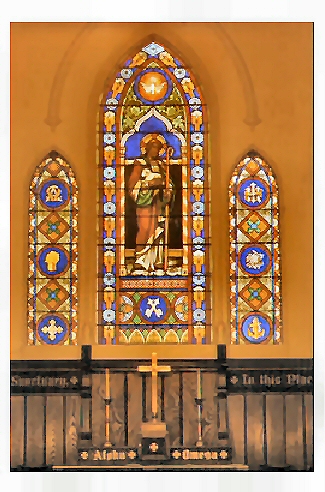
The east wall of St. Peter’s houses a traditional
triptych-form stained glass window composed of three panels, pointing
to the centrality of Jesus Christ in our lives. The center panel also
identifies our Patron saint, St. Peter. As with most triptychs, the
central panel is dominant and the left and right panels are descriptive
of the central theme. The window should not be read from left to right,
rather it should be interpreted from the center out.
The focal point of the center panel depicts Jesus as
the Good Shepherd. Throughout the first thousand years of the Christian
Era, Christ was portrayed most frequently as the Good Shepherd. The
ancient Hebrews thought of God as the shepherd of Israel and this form
of thinking was adopted by the early Church. In the east window, Jesus
is represented as the young shepherd bringing home the lost sheep. With
one arm he cradles the animal close to his bosom, with the other hand
he holds the shepherd’s staff. The shepherd, a symbol found in the
catacombs, calls to mind the loving care of Jesus, the Good Shepherd.
The halo-like effect, or nimbus, around Jesus’ head
is emblematic of sanctity and denotes a person recognized for unusual
piety, such as apostles, martyrs, and saints. Rays of light are ancient
emblems of divine power. A three-rayed nimbus, such as is depicted in
the Good Shepherd window, signifies divinity and is used only with the
three Persons of the Trinity.
Now when all the people were baptized, and when Jesus also had been
baptized and was praying, the heaven was opened, and the Holy Spirit
descended upon him in bodily form, as a dove, and a voice came from
heaven, “Thou art my beloved Son; with thee I am well pleased. ” (Luke
3: 21,22) ,
Directly above Jesus is a descending dove.
Traditionally the dove expresses innocence and purity. Surrounded by
its own nimbus, the dove is a traditional symbol of the Holy Spirit.
Here the dove signifies the Holy Spirit and the presence of God as
hovering over the water at Creation, and above Jesus at his baptism.
The left and right panels are both symmetrical in
denotation and design. Together the panels further describe and point
to Jesus’ meaning in our lives. Each panel houses a sacred monogram for
Jesus in the upper section. The left panel presents an Alpha and Omega
(AR), the familiar first and last letters of the Greek alphabet.
Together, these symbols, were used in the early Christian Church to
denote the eternity and infinitude of God. Jesus is the alpha and the
omega, he is the beginning and end of all things. (See Hebrews 13: 8,
Revelation 1: 8).
A decorative IHS or iota, eta, sigma is found in the upper right panel.
?????IHIOYI is the Greek spelling of Jesus. The first three letters,
???/HZ, are essentially the abbreviation of Jesus’ name in Greek. When
this is transcribed from Greek into Latin it appears as IHS. While the
???IHZ form for Jesus’ name is more ancient, the second form,
??IHS, is now more common. Both forms, however, are correct. Like
the alpha and the omega in the right panel, the letters are intertwined
for ornamental purposes.
The center sections of the left and right panels respectively picture
wheat and a cluster of grapes. These symbols represent the bountiful
gifts that come from the earth and are given to us from God. We, in
turn, take them and make them into bread and wine and offer them back
to God in the Holy Eucharist. Jesus said, “I am the bread of life, he
who comes to me shall not thirst” (John 6: 35). The wheat and the
grapes represent the life giving force, Christ’s body and blood, which
was given for us on the cross. In the Holy Communion we receive
Christ’s body broken and blood shed I with thanksgiving.
The cross is the primary symbol for Christianity. It was on the cross
that Christ died for our sins. It is only fitting the lower sections of
the outside panels each include this important symbol. The left panel
features a Cross Trefflee, which is also known as a Cross Botonnee.
This beautiful form of the cross is appropriately named for the ends of
the cross which formed as trefoils. The Cross Trefflee is widely used
wherever a decorative style of cross is needed. It is very popular and
is often used to decorate corporals, stoles, or exteriors of buildings,
because it is easily executed in architectural form.
The lower right panel features an anchor, a traditional symbol of hope.
The anchor is an ancient form of the cross found from the earliest of
Christian history. The stock and the shank form the familiar
cross-shape. Many anchor crosses are found in Roman catacombs or burial
places of early Christians. The early Church described itself as “the
ark of salvation” and often depicted itself as a ship. The anchor, or
Jesus, then represents the stability in an unstable sea or security in
an insecure world.
There is one final symbol in the lower portion of the center panel.
These are the keys that represent our patron saint, Saint Peter. They
are also representative of Peter’s relationship to Jesus. Jesus
figuratively gave the keys to the Kingdom to Peter along with the power
to bind and to loose (Matthew 16: 19). There are two traditions within
the church about the keys, both are non-scriptural. The first is that
the keys were both silver and that they were the keys to the Kingdom of
Heaven. The second tradition is that the keys were made of two
different substances, gold and iron. In this tradition the gold key is
the key to heaven, while the iron key opens the gate to hell. The keys
found in the East window are different, if only slightly, in shade.
OSBORNE
& DAVIS MEMORIAL WINDOW Front Window - South Side
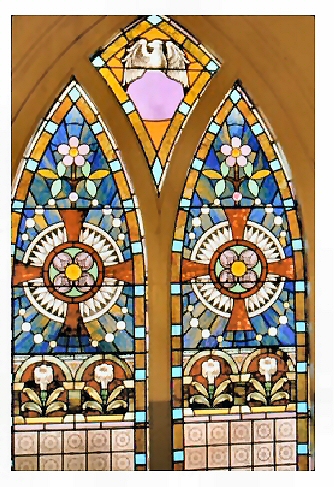
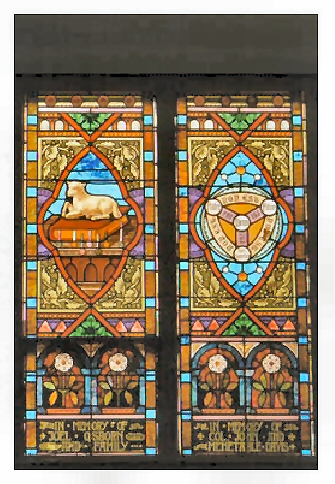
The Joel Osborne and Col. John and Mehetable Davis Memorial Window, the
Front Window of the South side wall, is visually stimulating and highly
symbolic. The symbols of the window seem to reach beyond themselves and
are both poetic and visionary in character.
Then I looked, and I heard around the throne and the living creatures
and the elders the voice of many angels, numbering myriads of myriads
and thousands of thousands, saying with a loud voice, “Worthy is the
Lamb who was slain, to receive power and wealth and wisdom and might
and honor and glory and blessing!” And I heard every creature in heaven
and on earth and under the earth and in the sea, and all therein,
saying, “To him who sits upon the throne and to the Lamb be blessing
and honor and glory and might for ever and ever!” Revelation 5:11-13
The lower left panel depicts the Agnus Dei or Lamb of God reclining on
a book with seven seals and seated upon an altar. The lamb is an
ancient symbol of the absolute faultless creature that was offered as a
burnt sacrifice to God by the ancient Israelites for their sins. The
offering to the Lord was complete; the lamb was not simply roasted, but
fully burnt and consumed. In Christian symbolism, Jesus is the Lamb of
God who was sacrificed totally in his “one oblation of himself once
offered, a full, perfect, and sufficient sacrifice, oblation, and
satisfaction, for the sins of the whole world” (BCP 334). The Lamb
rests on the Book with seven seals because he alone, having been slain,
is worthy to open the seals of the book which contains the fixed
purposes of God for all eternity. The altar represents both the
sacrificial altar and the throne of God. This panel of the window
honors Christ and his sacrifice while looking to the future God has in
mind for us.
Go therefore and make disciples of all nations, baptizing them in the
name of the Father and of the Son and of the Holy Spirit, teaching them
to observe all that I have commanded you and lo, I am with you always,
to the close of the age. Matthew 28:19,20
The lower right panel presents an early understanding of the doctrine
of the Blessed Trinity. The belief that there is one God but three
Persons is depicted through the use of a series of circles and a
slightly rounded out triangle. The Father (Pater) is God (Deus); the
Son (Filius) is God; and the Holy Spirit (Spiritus San& us) is God.
But the Father is not the Son, and the Son is not the Holy Spirit, and
the Holy Spirit is not the Father. The triangle is depicted pointing
downward, because of the filioque (Holy Spirit) clause, which was added
to the creed at the Council of Nicea. The clause which suggests that
the Holy Spirit is subordinate to and proceeds from the Father and the
Son, was controversial. As a result the Church in the East split away
from the Church in the West. This panel, which depicts the doctrine of
the Trinity, honors God and the Church.
The upper halves of both the left and right panels are perfectly
symmetrical. Each panel contains a large patee cross. This beautiful
form of a cross, with four equal length arms slightly curving outward,
has been used widely throughout the centuries for decorative purposes.
Three circles, which continue the Trinity theme from the lower half of
the window, overlay the patee cross. The outermost circle takes the
shape of a scalloped nimbus which denotes holiness. Just above the
cross on each panel is a lavender daisy. The daisy is a symbol that
represents the gift received by the pure light of day. The daisy or
“day’s eye” gets its name from the fact that the flower opens at
sunrise and closes each day at sunset.
And round the throne, on each side of the throne, are four living
creatures, full of eyes in front and behind: the first living creature
like a lion, the second living creature like an ox, the third living
creature with the face of a man, and the fourth living creature like a
flying eagle. Revelation 4:6b, 7
The top panel depicts a flying or rising eagle, a symbol with multiple
meanings. Traditionally, each of the four living creatures in the
Revelation according to John have been assigned to the four
evangelists. The rising eagle was assigned to St. John the Evangelist
because of the way in which his gaze in his writing pierced further
into the mysteries of heaven than that of any man. Since the second
century, the four living creatures have also been assigned to four
events of Christ’s life: Man (the Nativity), the Ox (his sacrificial
death), the Lion (his victorious resurrection) and the Eagle (his
Ascension). in rare instances, the eagle doubles for a symbol of the
Holy Spirit. Irenaeus, in his writing, likened the eagle to “the Spirit
hovering with his wings over the Church.” *
The entire window is bordered in blue and red, traditional colors for
heavenly truth and martyrdom, love and hate respectively. The frequent
use of grapes and leaves ties into the imporance of eucharistic
sacrifice. Unique to this window is the use of architecture as a
unifying devise. The columns and arches in both the upper and lower
panels give the window a sense of structure and solidity. The banks of
lilies, common to many memorial windows, are traditional symbols for
the resurrection.
Taken together, the symbols of this window honor the holy one of God,
the agnus dei, the doctrine of the Trinity, and therefore the Church as
a whole. Rich in color and character, this highly symbolic window seems
to lure the viewer, like John’s writings, into another realm.
Col. John Davis
Col. John Davis was the son of Capt. Joseph and Mary (Wheeler) Davis,
he was born in Oxford (then Derby) on Sept 28, 1755 and died in Oxford
On Nov. 11, 1848; a lifespan of 93 yrs. 1 month and 29 days. He was
buried in St. Peter’s Cemetery in Oxford. John attained the rank of
Colonel commanding the 32nd Regiment of CT Militia. He served in many
capacities at St, Peter’s Church including warden, Moderator and
Convention Delegate. The land for the first church building and
cemetery was acquired from his father, Capt. Joseph Davis. On Oct. 4,
1782 he married Mehetable Thomas of New Haven.
*“ He was a man much respected in and about Oxford, for his sterling
qualities both as a citizen and neighbor. When he was 90 years old he
broke a colt and rode him from Oxford to New Haven; a distance of 12-
15 miles.” * Davis Family Genealogy, Silas Bronson Library, Wtby., CT
Mehetable Thomas
The daughter of Reuben and Rhoda (Clinton) Davis of West Haven, born
Dec. 10, 1764 in New Haven, and died in Oxford Dec. 27, 1852, a
lifespan of 88 yrs, 8 months and 15 days. She was buried in St, Peter’s
Cemetery, Oxford, next to her husband. Mehetable and John had 14
children, all born in the same house on Chestnut Tree Hill In Oxford.
Their grandson, the Rev, Sheldon Davis was an Episcopal clergyman and
filled the pulpit at St, Peter’s in 1877.
Joel Osborne
The only son of Hiram and Sarah Finch Osborn was born in Oxford in 1821
and died in Oxford on May 25, 1871 at age 50. He married Catherine S.
Washburn (Washband) on June 11, 1846. Catherine was born Aug 25, 1823,
the daughter of Josiah S. and Catherine (Smith) Washburn, and died Feb.
2 1876 * ‘All during his honorable and useful life he lived in the
Wheeler Homestead and was one of the most popular men in town-socially
and politically. He represented the town several times in the
Legislature and filled every office in town.” * The Seymour Record,
Sept. 3, 1914.
HARRY
& MARY SUTTON WINDOW
Center Window - South Side
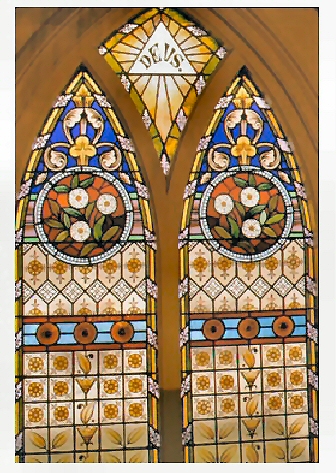
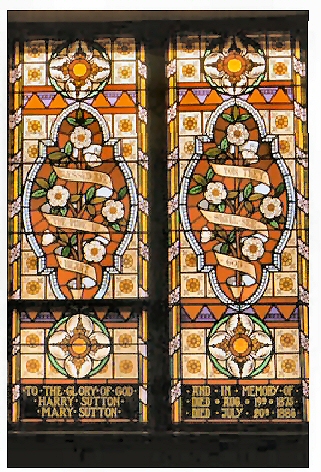
The Holy Trinity is the focus of the top panel, as well as the entire
top half of the window. A triangle with the Latin word Deus (God)
inside is the focal point of this panel. The triangle is a traditional
symbol for the Trinity. Each side of the triangle represents one of the
three persons of the Trinity, Father, Son and Holy Spirit. Without any
one of the three sides the triangle collapses. Likewise, without any
one of the three persons of the Trinity our understanding of God is not
complete. A gold lozenge shaped nimbus surrounds the central symbol.
The nimbus signifies the divinity or divine glory of God.
The upper panels are perfectly symmetrical and continue the Trinitarian
focus of the top panel. Uppermost in each panel is a shamrock
surrounded by a traditional heraldic patterned trefoil. Both the
trefoil and the shamrock are symbols of the Trinity because of the
three leaf pattern inherent in their design. Legend suggests that St,
Patrick picked shamrocks and used them as illustrations for the Trinity
when he preached to the pagans in Ireland. The shamrock and trefoils
are set on a rich blue background which traditionally stands for a
heavenly love or an unveiling truth.
Just below the shamrock and trefoil combination is a collection of
three lilies in a large circle with a red background. The circle, which
is never-ending, suggests the eternality of God. Also eternal are the
three persons of the Trinity as suggested in the three lilies. One
final pattern of three is found below each lily circle. There are three
smaller bronze or gold circles lying on a blue field with red borders.
This section of the window seems to almost separate the upper and lower
portions and, in some ways, to separate the earthly concerns expressed
in the lower half of the window from the heavenly promise represented
in the upper half.
Blessed are the pure in heart, for they
shall see God. (Matthew 5: 8)
Again, the lower half of the window is perfectly symmetrical in every
way. The focus of these two panels is the colorful heraldic shields and
their contents. Purity and immortality are represented in the lilies
which pictorially represent the Easter message. Just as new life is
released from what appears to be a dead bulb lying in the ground, so
too, God brings new life out of what was once considered dead,
Wrapped around these symbols of the resurrection is a scroll containing
the sixth beatitude: “Blessed are the pure in heart, for they shall see
God.” The Sixth beatitude is perhaps one of the most outstanding
because it seems most inaccessible. We hardly know which is more beyond
us, the condition or the promise - purity of heart or seeing God. To
live a life that is “pure in heart” is to live a life focused on God
alone; it requires rightness of mind and singleness of heart. The
beatific vision has been the agelong goal both of philosopher and
saint, but this beatitude promises more than mere vision - it promises
our deepest longing - to see God! Scholars have interpreted this verse
in two ways, First, if in this life we live a life that is pure in
heart, we will begin to see and recognize God at work around us. The
second view states that if we live a life with purity of heart in this
realm, in the life to come we will see God face to face.
All three panels are tied together with a border of green and gold,
colors which represent spring, triumph, regeneration of the soul
through good works, and life after death. Overall, the window may be
interpreted from the bottom up. It is God who is our shield and must be
our focus through the trials and tribulations of this life. It is our
hope and God’s promise, that in so much as we able to live a life “pure
in heart”, we will come to know God in this world and in the life to
come see God face to face. Through the use of colors and design, our
eyes are drawn upward through the gate of heaven where we come to know
God more fully as Father, Son and Holy Spirit. Beyond that heavenly
place resides God, the pinnacle of divine glory, whom we will
ultimately come to see face to face.
Harry
Sutton
Harry was baptized at St. Peter’s in 1817 presumably
by The Rev, Aaron
Humphrey. He was confirmed in 1838 at St. Peter’s church. Harry died on
Aug. 19, 1875 and was buried in St. Peter’s Cemetery, At the Annual
Meeting on April 2, 1874 he was elected a Warden of St. Peter’s Church,
Harry and Mary Antoinette Smith were married on May 9,1833 at St.
Peter’s
Mary
Antoinette Smith
Mary, the daughter of Ira H, and Nabba Prindle
Smith, and granddaughter
of the Rev. Chauncey and Rosanah Prindle, was baptized at St. Peter’s
in 1817 by the Rev. Aaron Humphrey. She married Harry Sutton on May 9,
1833 and they lived on the Seymour Rd. Mary died July 20,1886 and was
buried in St. Peter’s Cemetery, Oxford. The Rev, Chauncey Prindle was
the first settled minister at St, Peter’s.
FAIRCHILD
MEMORIAL WINDOW
Rear Window - South Side
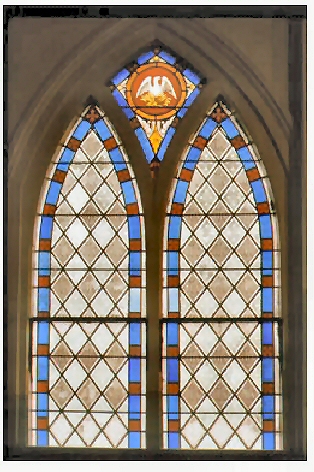
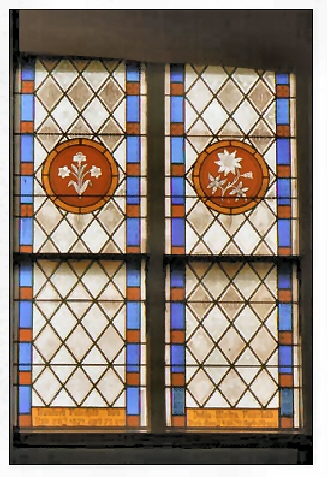
The Hanford and
Delia Alvira
Fairchild Memorial Window is symmetrical and simple in design. is very
traditional and the least ornate of St. Peter's windows. This window
employs symbols of the Resurrection, Jesus Christ and the Holy Spirit.
Common to many memorial windows, the overall theme of this window is
the promise of the Resurrection made possible in Christ Jesus.
Each panel contains one primary
symbol housed in a circle representing the eternality of God. The left
side panel contains a lily, a symbol of the Resurrection. Out of a
decaying bulb in the ground, new life is released in this symbolic and
traditional Easter symbol, the lily.
The right panel contains a more
obscure flower in Christian tradition, the Columbine. Derived from
columba, the Latin word for "dove", the Columbine is said to look like
a dove in flight. The dove is a traditional symbol for the Holy Spirit.
A Columbine stalk generally has seven blossoms, which are associated
with the seven gifts of the Holy Spirit as noted in the Revelation of
St. John 5:12: "power and wealth and wisdom and might and honor and
glory and Blessing!" The Columbine is also associated with the Spirit
of the Lord in the following Isaiah passage:
"There shall come forth a shoot
from the stump of Jesse, and a branch shall grow out of his roots. And
the Spirit of the Lord shall rest upon him, the spirit of wisdom and
understanding, the spirit of counsel and might, the spirit of knowledge
and the fear of the Lord. (Isaiah 11:1-2)
The final dominant symbol, a
Phoenix, is housed in the top panel. The Phoenix, which is a mythical
bird, was thought to be a sign of the Resurrection by many early
Christians and was often used on burial stones. Briefly put, the legend
tells of a bird that lives for five hundred years, builds a nest for a
funeral pyre and burns itself to death. Then it rises from its own
ashes and starts a new life. The legend has a long and broad
history in Greece, Egypt, Arabia and Rome. The first known Christian
writer to take the legend over was Clement of Rome about 98 A.D. He
gives the legend in his Letter to the Corinthians and makes it an
example of the Creator of the universe bringing about the resurrection
of the faithful. Later, the phoenix came to signify the Resurrection of
Christ.
All three panels are
framed in rich and deep hues of a red and blue border. Red is the
traditional color for martyred saints, love. hate and sovereign power.
Blue is the traditional color for heavenly love and the unveiling of
truth. Both side panels share a common (although faded)
background of diamond-shaped glass pieces each containing one of
two symbols for Jesus Christ.
The first symbol is that of a Cross Botonnee
or budded cross. This traditional cross has trefoils on the end of each
arm and suggests a young immature Christian. Hanging on the cross which
recalls Jesus' death is the crown of thorns placed on Christ's head by
the soldiers at his Passion and Crucifixion.
The second symbol is a decorative IHS or iota,
eta, sigma. IHEOYE is the
Greek spelling of Jesus. The first three
letters. IHI, are essentially the abbreviation of Jesus' name in Greek.
When this is transcribed from Greek into Latin it appears as IHS.
Overall, the Fairchild
Memorial window has its background and foundation in Jesus Christ,
(Cross Botonnee and IHS) who was crucified, died and was buried. On the
third day, like the Phoenix, he rose again. Through the gift of the
Holy Spirit (Columbine) we share our hope in the promise of the
Resurrection, represented by the Lily and the Phoenix.
Hanford
Fairchild
Hanford was the son of Ebenezer and Eunice
(Lewis) Fairchild. He was born Mar. 7, 1799, confirmed at St. Peter's
Mar. 11,1860 by Bishop John Williams and died Nov 28, 1871, aged 73
years. He was buried in St,. Peter's Cemetery. He was a carpenter and
for a number of years was a postman from Oxford to New Haven. He served
as Committeeman and Vestryman at St. Peter's for many years. On Jan.
10, 1822 he married Delia Elvira Twichell.
Delia
Elvira Twichell
She was born Oct 7, 1800 and in 1801 was
baptized by the Rev Richard Mansfield, the founder of St. Peter's
Church. She died June 14, 1870 and was buried in St. Peter's Cemetery.
OSBORN
& DAVIS MEMORIAL WINDOW
Front Window - North Side
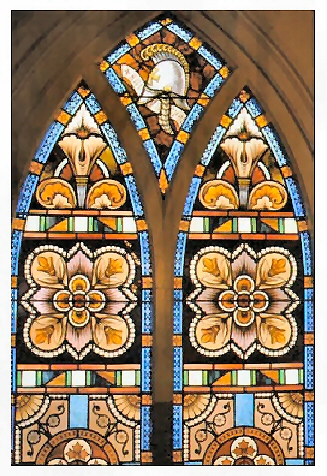
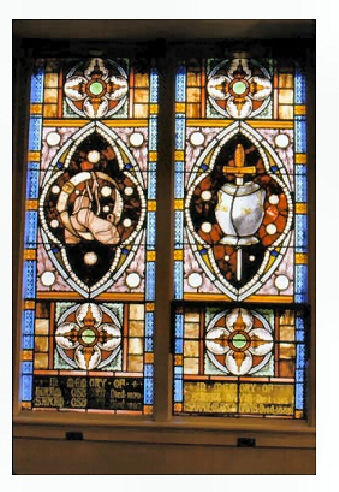
"Finally, be strong in the Lord
and in the strength of his might. Put on the whole armor of God, that
you may be able to stand against the wiles of the devil. ...Stand
therefore, having girded your loins with truth, and having put on the
breastplate of righteousness, and having shod your feet with the
equipment of the gospel of peace; besides all these, taking the shield
of faith, with which you can quench all the flaming darts of the evil
one. And take the helmet of salvation, and the sword of the Spirit,
which is the word of God." -- Ephesians 6:10,11, 14-17
The Osborn and Davis Memorial window is the only window at St. Peter's
which draws all of its images from only one scripture passage: The
Whole Armor of God. Paul's letter to the Ephesians focuses on unity
with Christ in standing against the wiles of the devil by putting on
the Whole Armor of God. The window is best read from bottom to top,
crossing back and forth from the left and right panels and following
Paul's instructions in the passage about how to do
battle with evil both in this world and the next.
"He shall not judge by what his eyes
see, or decide by what his ears
hear; but with righteousness he shall judge the poor.... Righteousness
shall be the girdle of his waist, and the faithfulness the girdle of
his loins." -- Isaiah 11:3-5
Much of the imagery for the Ephesians passage can be found throughout
the Old Testament. As a devout Jew, Paul drew on the rich pictures
already in the Hebrew Scriptures to pull together the "Whole Armor of
God" imagery. In instructing the community, Paul first tells the body
to gird their loins with truth. The community must live in truth, see
themselves as truthful and be truthful with others; so must we. The
girdle or belt of truth is found in the lower left panel.
"He put on righteousness as a
breastplate, and a helmet of salvation
upon his head, he put on garments of vengeance for clothing and wrapped
himself in fury as a mantle." -- Isaiah 59:17
It is first and foremost
God's armor Paul is referring to throughout the passage and it is
God's armor that we must put on. The community Paul addresses is
sinful. Having confessed its sin, God intervenes and offers the
righteousness which God alone can provide. Without a breastplate, a
warrior would be susceptible to injury. Likewise, without God's
Breastplate of Righteousness, we, too, are vulnerable to the enemy. The
Breastplate of Righteousness is found in the lower right panel.
The Sandals of the Gospel of
Peace are found in the lower left panel intertwined with the belt of
truth. Remembering Isaiah's passage (52:7): "How beautiful upon the
mountains are the feet of him who brings good tidings, who publishes
peace, who brings good tidings of good," Paul gently reminds his
hearers of the temptation to not live by the law of love when faced
with evil. He seems to remind them and us to put on our shoes not so
much as to protect our feet, as to encourage us to lace up in love and
to step into grace. In today's idiom Paul's seems to say, that we must
be careful to "walk our talk!"
The shield of Paul's day was
so large that it would cover an entire man. Made of canvas or hide
stretched over a wooden frame, the shield would easily serve as a
barrier from the flaming darts or spears with fire-lit, pitch-covered
tips to which Paul refers. The shield is the largest of all God's
armor. Faith, the natural by-product of continually renewing one's self
in commitment to God, will be our best shield when faced with both the
verbal and physical assault of the evil one. The Shield of Faith is
pictured in both lower panels and frames the other articles of God's
armor.
The Helmet of Salvation finds its
roots in the Isaiah passage quoted above. A helmet is essential to
protect the head of the soldier in battle. Jesus who is the head of the
Body of Christ, the Church, has given us the gift of salvation through
his death. We, like Paul's listeners, are to put Jesus on as our
helmet; he alone will protect us. The Helmet of
Salvation is found, quite naturally, in the top panel or the head of
the window.
"...the word of God is living and
active, sharper than any two-edged
sword, piercing to the division of soul and spirit, of joints and
marrow, and discerning the thoughts and intentions of the heart."
--Hebrews 4:12
"Sticks and stones can break my bones, but names can never hurt me," is
an age-old children's rhyme that always rings false. Physical injuries
will heal with time, but the wound inflicted with bitter and sour words
can cause a lifetime of misery. The only offensive weapon in God's
arsenal is the Sword of the Spirit which is the Word of God.
God's servants yield this sword through their spoken word, "Therefore I
have hewn them by the prophets, I have slain them by the words of my
mouth, and my judgment goes forth as the light" (Hosea 6:5). It is our
knowledge and use of the scripture, of God's Holy Word, that will be
our line of defense against the enemy. The Sword of the Spirit, which
is the Word of God, is found in the lower right panel with the
Breastplate of Righteousness.
The entire window is designed in
typical heraldic fashion using rich hues of red, blue, silver and gold.
Overall, the window and Paul's Ephesians passage serve to remind us
that God both wears and supplies the armor for us to wear in the
ongoing battle with evil in the world. Just as Christ triumphed over
evil, we, too, can stand in unity with him, by putting on the Whole
Armor of God and living our lives in Christ's ways.
Burritt
Davis
Son of Col. John and Mehetable (Thomas) Davis,
Burritt was born in
Oxford July 12, 1806 and died there on May 24, 1893 aged 86 years, 10
months and 12 days. After his marriage on Dec. 11,1828 to Sarah Electa
Osborne he remained on the Old Homestead on Chestnut Tree Hill, where
all his children were born and where he died. Burritt held many offices
at St. Peter's Church.
Sarah
Electa Osborne
Sarah was the daughter of Hiram and Sarah (Finch)
Osborne. She was born
in Oxford on May 6, 1809 and died there on Jan. 4, 1889; aged 80 years,
7 months and 28 days. Sarah and her husband Burritt were both confirmed
at St. Peter's Church on Sept. 9,1828 by Bishop Brownell.
Hiram
Osborn
Hiram came from Goshen in his early life and died in Oxford on Sept.
13,1870. He was 85 years old making him bom circa 1785. He is first
mentioned in the church records on Jan. 11, 1820, having been appointed
Collector of Church taxes. He was one of the largest contributors for
the building of the new church. Hiram married Sarah Finch, at Oxford,
on Jan. 29,1806.
Sarah Finch
Sarah was born in Oxford about 1785, the daughter of Daniel Finch and
Sarah Wooster and died there on Jan. 3 1863, at 78 years of age. Sarah
and Hiram were the parents of Sarah Electa Osborne and Joel Osborn.
ATWATER TREAT MEMORIAL WINDOW
Center Window - North Side
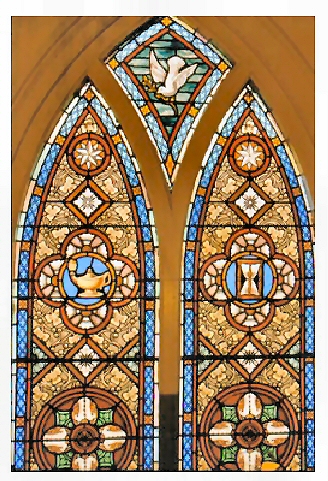
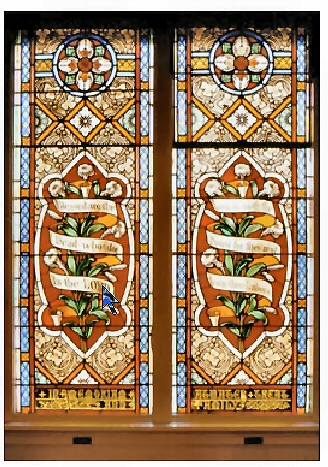
The Center Window on the North side wall
tells the story of God's eternal promise to those who believe, "Blessed
are the Dead who die in the Lord." The Atwater Treat Family Window is a
memorial window that recalls God's presence in death and promise of
life eternal to those who believe.
"At the end of forty days Noah
opened the window of the ark.... Then he sent forth a dove...but the
dove found no place to set her foot, and she returned to him.... He
waited another seven days, and again he sent forth the dove out of the
ark: and the dove came back to him in the evening, and lo, in her mouth
a freshly plucked olive leaf: so Noah knew that the waters had subsided
from the earth." (Genesis 8:6-11)
The dove with an olive
branch
pictured in the upper section of the North Center Window is a symbol of
the Flood. It denotes peace, forgiveness and anticipation of new
beginning after the death of the Flood and new life in God's romise
"that never again shall all flesh be cut off by the waters of a flood,
and never again shall there be a flood to
destroy the earth" (Genesis 9:11).
The combination of the lamp and
the hourglass recalls the parable of the Wise and Foolish Maidens
(Matthew 25:1-13) in which five maidens took extra oil for their lamps
on a trip to meet the bridegroom, while the other five failed to bring
adequate provisions. When the bridegroom was about to arrive, the five
maidens in need of more oil went to the dealers to purchase some and
missed their opportunity to go into the marriage feast. When they
knocked at the door, Jesus said to them, 'Truly, I say to you, I do not
know you.' Watch therefore, for you know neither the day nor the hour."
(Matthew 25:12,13).
The maidens represent all
expectant believers in Jesus and the parable contrasts the two ways of
being faithful while waiting for the Lord's return. The Wise maidens
were prepared and ready for Jesus' return, regardless of the hour. The
sands ran through the hourglass faster than the foolish maidens could
have imagined, and the admission door to the Kingdom was shut in their
face. So also must we be ready, because we never know when Jesus may
invite us to join him.
"Blessed
are the Dead who die in
the Lord, even so saith the spirit for they rest from their Labors."
Revelation 14:13
This verse of scripture is taken
from the fourteenth chapter of The Revelation to John. In this section,
three angels express the consequences of divine judgment for humanity;
the criterion will be whether one followed the beast or the Lamb. The
followers of the beast will suffer continuous and unending punishment
by fire. This description of punishment is not an opportunity for the
readers to gloat over their enemies; rather it functions as an
incentive for them to "keep the commandments of God and the faith in
Jesus" (v. 12). The implied threat of punishment in vv. 9-12 is
balanced by the suggestion of reward in the appended sayings in v. 13.
Those who "follow the
Lamb...are spotless..." (v.4,5) and the center north window employs the
traditional symbol of purity and virginity - the Lily. Often associated
with St. Mary, St. Joseph, St. Anne, the mother of Mary, and St.
Gabriel, the Lily is most often associated with Easter, the Day of
Resurrection of our Lord. The promise of new life in Christ, which is
the entire message of the window, is available through the blood of
Jesus which is represented by the border of vines and grapes that tie
together the various symbols of the window into a whole unity.
Atwater
Treat Family
Atwater, the son of Elijah Treat and Esther
(Rhodes) Mallory, was born Sept. 4, 1810 at Oxford and died Feb. 2,
1888. He was baptized, confirmed and on Oct. 30, 1835 married Elizabeth
Ann Terrell, daughter of Eli and Eunice (Hitchcock) Terrell, at St.
Peter's, Oxford. She was born Aug. 5,1812 and was also baptized and
confirmed at St. Peter's. Elijah and Esther were the parents of Elijah
B. Treat, born Nov. 13, 1850. He was baptized Sept. 17, 1854 and
confirmed on May 9. 1867.
On April 23, 1873 he and Sarah A. Curtiss, daughter
of Charles L. and
Delia (Lewis) Curtiss, were married at St. Peter's Church. Their son,
Atwater Curtiss Treat was born Feb. 2, 1874, baptized, confirmed and on
May 21, 1913 married at St. Peter's, Jennie Andrus, daughter of Rolla L
and Mary Frances(Treat) Andrus. Elijah B. served St. Peter's faithfully
as a Sunday School teacher, Clerk, Treasurer and Senior Warden for many
years. Atwater C. served as Vestryman, Cemetery Chair-
man, Warden from 1935-1955 and as parish clerk from 1912-1951. His wife
Jennie succeeded him as clerk serving from Jan. 1952 through June of
1959.
Their daughter Marion Treat DeBisschop was
Treasurer of the ECW
for many years and her husband Charles served serveral terms as Senior
Warden. Their daughter, Marilyn DeBisschop Serus, is
the Senior Warden at the present time, the first woman to hold this
position.
BUNNELL,
TERRILL MEMORIAL WINDOW
Rear Window - North Side

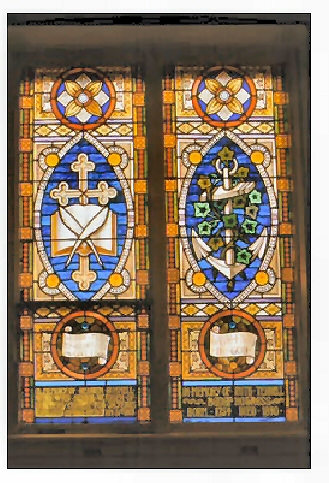
The Rear Window of the North side
wall tells the story of God's eternal promise to those who believe,
"Blessed are the Dead who die in the Lord." The Bunnell, Terrill Window
is a memorial window that points to the promise of Jesus' atoning death
to those who truly "have faith in
God."
The top panel of the window
features a pelican feeding her young. The Pelican is an ancient symbol
for Jesus' Atonement. Legend claims that the mother pelican draws blood
from her own breast in order to provide for her offspring. Likewise, It
is through Christ's giving of his own blood that we too have life.
The upper portions of the left and
right panels are both symetrical in design and use of symbols. Each
side features a daisy and a circle inside a trefoil with three
intertwining circles, is the traditional symbol for the Trinity. The
three circles represent the three persons of the Trinity, Father, Son,
and Holy Spirit and point to the equality, unity and co-eternal nature
of God's very being of one in three and three in one. The three rayed
Nimbus of both the
circle and the trefoil represent the divine power of God and the three
persons of the Trinity.
The lower panels are also
symetrical in design while featuring a symbol of a Saint in a shield, a
portion of scripture on a scroll, and finally the names of the those
persons in whose memory the windows were given.
The left panel depicts a Cross
Botonnee, an open book and two pens. The Cross Botonne or budded cross,
with trefoils at the end of each arm, represents a young immature
Christian. The open book represent the Word of God, the Bible. Pens are
an ancient symbol used for Saints
of the Church who defended the faith in writing. Taken together, these
symbols stand for a fifth century Saint, Cyril of Alexandria. Cyril
gave much of his life to the defense of the truth of Christ's divinity.
Time and time again, he upheld the church against false doctrine in
writing.
"For I know that my Redeemer lives,
and at last he will stand upon the
earth; and after my skin has been thus destroyed, then from my flesh I
shall see God, whom I shall see on my side and my eyes shall behold,
and not another." -- Job 19:25-27
The scripture contained on the
bottom of the left panel comes from the book of Job, a lengthy story
that probes the depth of faith in spite of suffering. We enter the
story at the point were Job is completely isolated; his wife, family,
household and friends have deserted him and his body is wasting away.
Nevertheless, Job looks to the future and proclaims his faith in God,
his redeemer, in the midst of great pain and suffering.
The right panel contains an ivy covered anchor. Ivy
represents eternal life because of its continual green color and
fidelity because of the manner in which it clings to its support. The
anchor is an ancient symbol of hope in an unstable sea or security in
an insecure world. Together these symbols represent Saint Clement who
was bishop of Rome in the first century. Banished and persecuted from
his see, Clement was forced to work in the mines. He never gave up his
zeal to convert others to Christ. Legend claims that Clement met his
death, when in the midst of trying to win converts on a ship, he
was bound to an anchor and cast into the sea.
"And Jesus answered them, "Have faith in God. Truly, I say to you,
whoever says to this mountain, 'Be taken up and cast into the sea,' and
does not doubt in his heart, but believes that what he says will come
to pass, it will be done for him. Therefore I tell you, whatever you
ask in prayer, believe that you have received it, and it will be
yours." -- Mark 11:22-24
Jesus' proclamation to "have faith
in God" comes on the heels of the story of the withered fig tree. The
disciples were amazed at Jesus' power; he cursed and the fig tree
withered in their very sight. Jesus redirects their astonishment and
points to the source of his power - God. Jesus reminds his
disciples and us, that if we truly believe - with God anything is
possible.
Overall, the message of the window
is one of faith - specifically faith in God. Even though at times life
may seem difficult; even though we may suffer like Job; even though
there still are people in this world who do not believe in the Divinity
of Christ; even though some people are yet to be converted, we "know
that our redeemer lives" and we must still have faith in God through
the one who gave his blood for us, Jesus Christ.
Ruth
Wooster Terrell
The daughter of Joseph and Hannah Wooster, she
was born in 1754, one of 16 children and lived on Good Hill. She died
in 1840, On Dec. 9,1801 she married Phineas Terrell of Bethany. She was
47 years old and he was 53 years old. Phineas died in 1822 and in the
year after his death she gave the first piece of land to St. Peter's
Church. It consisted of 19 acres and today would cover most of Dutton
Road and include the land on Oxford Road just below the present
Rectory. In 1828 Ruth gave another 22 acres to the Church. Both Ruth
and Phineas are buried in St. Peter's Cemetery.
Reuben
Bunnell
Reuben was bom Dec 25, 1765 in Derby and died
Feb. 2, 1853 in Oxford, aged 87 years. His name first appears in the
church records on April 21, 1788 when it was voted he be made
"corrister". In 1812 he was made clerk, and in 1817 he was made
Treasurer. He served as Warden for 35 years.In 1811 he was on the
committee to dismiss the clergyman and find a new one. Reuben married
Sarah Sackett, who died on Sept. 6, 1851, aged 84, in Oxford. Both are
buried in St. Peter's Cemetery.
THE
VICTORY WINDOWS
Balcony
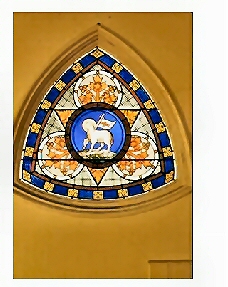
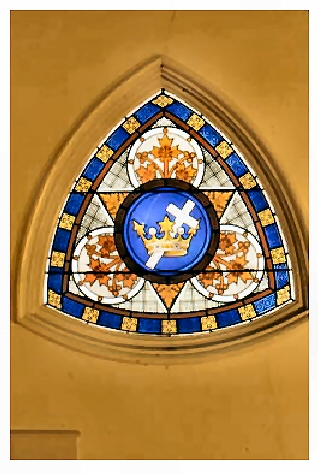
The East wall of St. Peter's balcony houses two smaller matching
stained glass windows/ Each window has a symbol of victory in its
center.
Both windows employ repeated use
of two triangles and four circles. One triangle frames the entire
window and the other serves to hold together a pattern of four circles.
The
triangles and circles are traditional symbols representing the Trinity
and the eternality of God respectively.
Together these symbols express an eternality in their continuous form
and an indivisibility in their interweaving. God is
circular or eternal and known as Father. Son and Holy Spirit. Take away
any one side of the triangles or any one of the
circles and the design would be out of balance, most assuredly as our
understanding of God would be out of balance without the Holy Trinity
or the eternality of God.
The three outer circles each contain
ornamental grapes on a vine which signifies the sacrament of Holy
Communion, Christ's body and blood. The entire design makes wide use of
the color gold which signifies purity and holiness of life. The window
is framed in rich and deep hues of a red
and blue. Red is the traditional color for martyred saints, love, hate
and sovereign power. Blue is the
traditional color for heavenly love and the unveiling of truth.
"The next day he saw Jesus coming
toward him, and said, 'Behold, the
Lamb of God, who takes away the sin of
the world!" -- John 1:29
Having baptized Christ, John
the Baptist referred to Jesus as the Agnus Dei or The Lamb of God is
depicted with the Banner of Victory in Southeast balcony
window.
This symbol of God the Son is depicted as a white lamb with gold
nimbus and a red cross upon a white banner supported by
a silver staff with a gold cross at the top, all on a blue field.
The symbolism goes back to Isaiah 53:7, "like
a lamb that is led to the slaughter," where the lamb was sacrifi cially
slain for the sins of the Jewish people. In Christian
tradition the lamb stands for the sacrifical nature of Jesus'
life and ministry, as well as his sacrifice upon the cross.
The standing lamb bearing
the cross-emblazoned banner of victory signifies the Resurrection,
Christ's victory over death. "At the Lamb's high feast we sing," an
Easter
hymn emphasizes the origin of this symbol in the paschal lamb. Two
lines in the original English version read:
"Now thy banner thou dost wave, Vanquished Satan and the grave."
The center symbol of the
window located on the liturgical north side of the balcony is the
well-known Cross and Crown combination often used for church
school awards. The
cross is a familiar symbol for Christ because it is the
instrument of his death. It is also a symbol of
Christianity. Theologically, it stands for the salvation, redemption
and atonement provided for us in Christ's death.
Crowns have been used to
denote sovereignity and kingship, or in other cases, as wreaths to
denote victory from ancient times. The idea that Jesus Christ received
his crown of victory when he ascended has made this Cross and Crown
symbol popular for both Easter and the Ascension. Together the Cross
and Crown symbolize both the kingship of Jesus and his victory over
death. Victory also belongs to us; it is the reward of the faithful.
Those who believe in the crucified Savior will also be victorious and
receive the crown of life.
"Do not fear what you are about to
suffer. Behold, the devil is about
to throw some of you into prison, that you may be tested, and for ten
days you will have tribulation. Be faithful unto death, and I will
give the crown of life." --Revelation 2:10
Thus our journey ends. The tour of
St. Peter's historic stained glass windows ends with the promise of
victory that is Christ's and that it ours who believe in Christ Jesus.
Front Windows
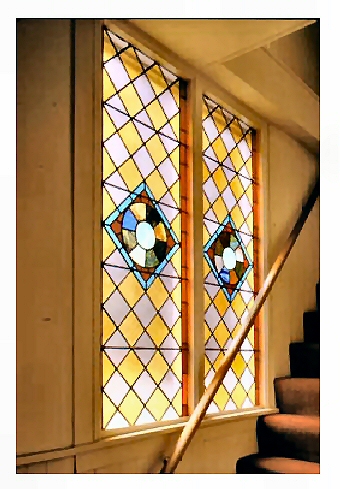
Front windows, one of a matched pair -- one on either side of front
door to the sanctuary,
Index
to Scriptures
Old Testament:
- Genesis 8:6-11
- Genesis 9:11
- Job 19:25-27
- Isaiah 11:1-2 .
- Isaiah 11:3-5
- Isaiah 52:7
- Isaiah 53:7
- Isaiah 59:17
- Hosea 6:5
New Testament:
- Matthew 16:19
- Matthew 25:1-13
- Matthew 25:12, 13
- Matthew 28:19,20
- Matthew 5:8
- Mark 11:22-24
- Luke 3:21,22
- John 1:29
- John 6:35
- Ephesians 6:10,11, 14-17
- Hebrews 13:8
- Hebrews 4:12
- Revelation 1:8
- Revelation 14:13
- Revelation 2:10
- Revelation 4:6b,7
- Revelation 5:11-13
- Revelation 5:12









